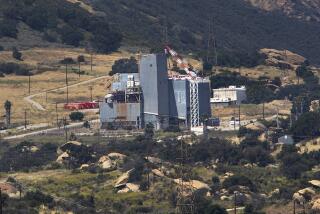Site Chosen for Ambitious Airport Project in Chicago
- Share via
CHICAGO — Chicago’s audacious bid to build a $10.8-billion airport in the midst of a recession moved a step closer to fruition Monday with selection of a site--a declining industrial area on the city’s southeast side that has thousands of homes, hundreds of acres of federally protected wetlands and more than two dozen toxic waste sites and landfills.
These obstacles, along with threatened lawsuits by groups opposed to the airport site, could yet scuttle the airport, which is reported to be one of the largest municipal public works projects ever attempted.
If the airport is built it could be the greatest single generator of jobs in the region’s history and would revitalize a part of the city, and a part of northwestern Indiana, that long has been in decline. But it is bitterly opposed by homeowners in the selected Lake Calumet area. And proponents of four other sites that were rejected still are hoping that federal regulators will reject the site because of the high environmental costs.
“It’s going to be an uphill fight,” Chicago Mayor Richard M. Daley said after a panel appointed to select the site settled on Lake Calumet Monday morning.
Selection of the site was a stunning victory for Daley, who flexed considerable political muscle to get it considered after it had been passed over by the site-selection panel in favor of other locations in the southern suburbs and in nearby Gary, Ind.
Two previous Chicago mayors had stonewalled the site selection process, fearing that a third airport might siphon flights and jobs away from O’Hare International Airport northwest of Chicago.
Daley began championing the southeast side two years ago, shortly after he won election to office. O’Hare, the nation’s largest airport, is overburdened. Studies had shown that O’Hare and the older, smaller Midway Airport would be turning away 15 million passengers a year by the year 2020 unless capacity was increased.
In forcing selection of his favored site against what had initially seemed to be insurmountable odds, Daley rivaled his legendary father, former Mayor Richard J. Daley, in his use of political clout to advance splashy, jobs-generating public works projects.
It was the vision and political might of the elder Daley that largely shaped modern-day Chicago. Among the massive projects he built during his 21-year reign was O’Hare, which sparked a growth boom on the city’s northwest side and today provides 50,000 jobs and pumps an estimated $11 billion a year into the economy of a six-county region.
The new airport will be smaller, but the city estimates that it would mean 235,000 new jobs in the southeast side by 2020; an estimated 40,000 of them would be permanent.
Monday’s vote was in some ways anti-climatic. The panel had already eliminated all but two sites--Lake Calumet and Gary. Since the 11-member panel was heavily weighted by Illinois members, Lake Calumet was a foregone conclusion.
Monday’s vote was split along state lines, 6 to 4, with Indiana’s four members voting for Gary.
More to Read
Sign up for Essential California
The most important California stories and recommendations in your inbox every morning.
You may occasionally receive promotional content from the Los Angeles Times.













